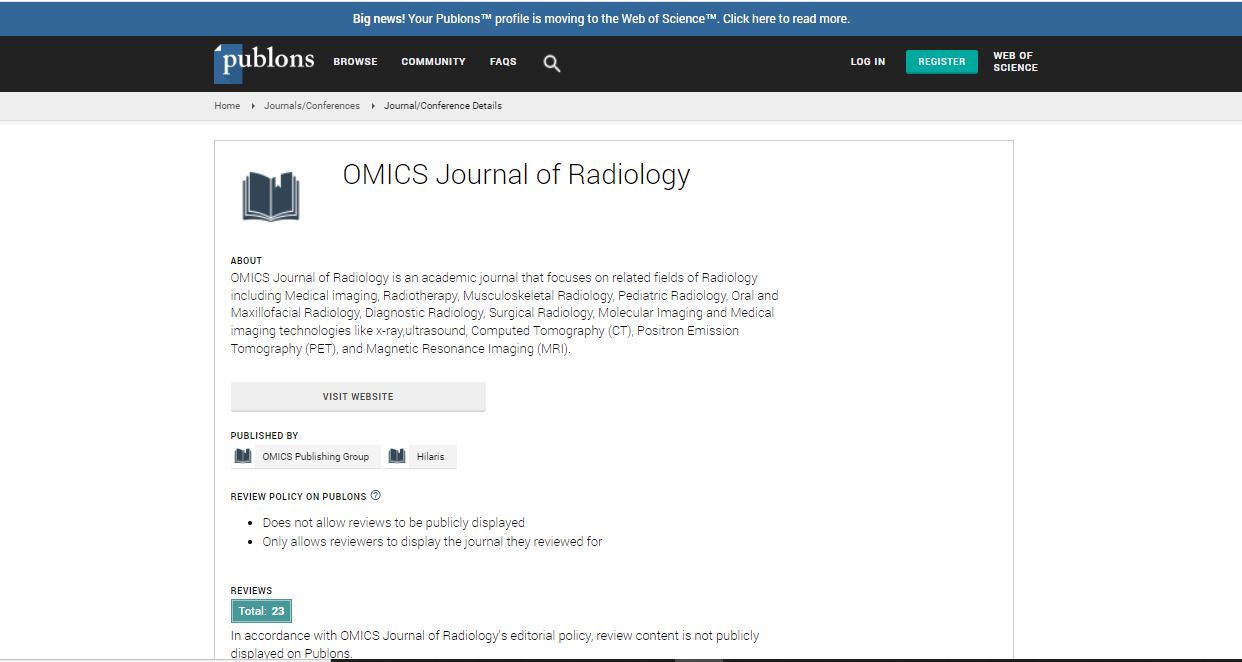Our Group organises 3000+ Global Conferenceseries Events every year across USA, Europe & Asia with support from 1000 more scientific Societies and Publishes 700+ Open Access Journals which contains over 50000 eminent personalities, reputed scientists as editorial board members.
Open Access Journals gaining more Readers and Citations
700 Journals and 15,000,000 Readers Each Journal is getting 25,000+ Readers
Google Scholar citation report
Citations : 551
Journal of Radiology received 551 citations as per Google Scholar report
Journal of Radiology peer review process verified at publons
Indexed In
- Index Copernicus
- Google Scholar
- Open J Gate
- Genamics JournalSeek
- ResearchBible
- Electronic Journals Library
- RefSeek
- Hamdard University
- EBSCO A-Z
- OCLC- WorldCat
- SWB online catalog
- Virtual Library of Biology (vifabio)
- Publons
- Geneva Foundation for Medical Education and Research
- ICMJE
Useful Links
Share This Page
Developing role of advanced MRI techniques for diagnosis of glioblastoma relapse after complex oncology treatment
3rd International Conference on Radiology and Imaging
Radim Jancalek
St. Anne��?s University Hospital Brno, Czech Republic
ScientificTracks Abstracts: OMICS J Radiol
Abstract
Glioblastoma (GBM) is the most common primary brain tumor of adults. Despite a multidisciplinary approach, GBM frequently recurs as a new gadolinium-enhanced MRI lesion at or near the site of the original tumor; thus, at the site of high-dose target volume for radiotherapy. An early differentiation between GBM relapse and changes in connection with oncology treatment (pseudoprogression) is still problematic by common imaging techniques. The project goal was to verify whether the combination of apparent diffusion coefficient (ADC) and MR spectroscopy increases specificity of a structural MRI for early differentiation between HGG relapse and pseudoprogression. Patients (n=24) with GBM and structural progression on MRI after neurosurgical resection and chemo-radiotherapy underwent DWI (ADC map) and 1H MR spectroscopy focused on N-acetylaspartate (NAA), choline (Cho), creatine (Cr), lactate (Lac), and lipids (Lip). The etiology of a lesion was established by a subsequent MRI or biopsy and correlated with results of the MR techniques. Compared to pseudoprogression, HGG relapse was characterized by a significantly lower ADC value, lower NAA concentration, and appearance of Lac+Lip spectra. We found very high sensitivity and specificity of ADC value (â�?¤1300x10-6 mm2/s) and Cho/NAA ratio (â�?¥1.4) to designate the MRI lesion with gadolinium uptake as GBM relapse. ADC value and MRS (mainly Cho/NAA ratio) have ability for the early non-invasive differentiation of GBM relapse from pseudoprogression after oncology treatment.Biography
Radim Jancalek has completed his PhD at the Masaryk University, Brno, Czech Republic. He started to be specialized in neurooncology, functional neurosurgery, and neuroimaging. He is the head of the Department of Neurosurgery, St. Anne’s University Hospital, Brno, Czech Republic, and the leader of the Neurooncology Research Group, St. Anne’s University Hospital. He has published more than 32 papers in reputed journals and has been serving as an editorial board member of repute.
Email: radim.jancalek@fnusa.cz

 Spanish
Spanish  Chinese
Chinese  Russian
Russian  German
German  French
French  Japanese
Japanese  Portuguese
Portuguese  Hindi
Hindi 
